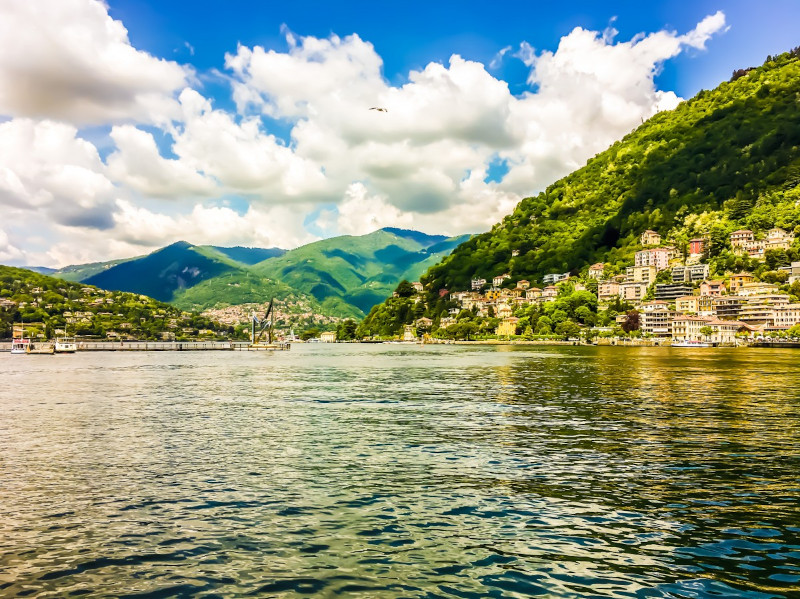
Lake Como Facts
- This stunning creation of geological processes most frequently goes by the name of Lake Como among those fortunate enough to know of it. This natural marvel also has a second name, however. That’s the much less commonly used term of Lake Lario.
- Though used far less often, the alternate term for the beautiful lake has a rich history itself. That’s because it derives from the Latin term Larius. The breathtaking beauty of the formation garnered it great appreciation even during the time of the Roman Empire.
- Even that long ago, it was a highly popular retreat for the wealthy and aristocratic. The site also constituted an extremely popular tourist attraction for the masses, even during that period. Since then, many famous people have had homes along its shore.
- In modern times, however, it earned yet another status. That’s due to the fact that it now serves as a backdrop for a magnificent UNESCO World Heritage Site. The Sacred Mountain of Ossuccio, a popular pilgrimage destination, now sits in the hills above it.
- The marvelous natural feature additionally merits appreciation for its various physical statistics. That’s true since the mind-boggling splendor of Lake Como is contained within the third-largest lake in its region. It’s also the fifth deepest lake on its continent.
- Its sheer beauty, combined with its various impressive physical dimensions, also recently garnered it an award. The Huffington Post named it the most beautiful lake on earth in 2014, due to, among other factors, its micro-climate and environment.
Related Articles
Lake Como Physical Description
The amazing Lake Como truly stands out from the majority of similar geological features. That’s due to its unique combination of purely visual appeal, and statistically high-ranked physical dimensions. The lake also packs these into a highly irregular general outline.
Overall, though, the lake has an extremely elongated shape. It boasts a maximum measured length of approximately 29 mi (46 km). Yet, its maximum measured width only equals about 2.8 mi (4.5 km). This gives it a total surface area of an impressive 56 sq mi (146 sq km).
The remarkable attributes of this product of time and local natural forces do not simply end there, however. The fabulous body of water further boasts a total shoreline length of almost 100 mi (160 km). Those make it the largest lake on its continent, outside of Norway.
It’s depth varies significantly from place to place. Overall, though, it possesses an average depth equaling roughly 505 ft (154 m). In some spots, however, its depths plunge much further. In fact, a few locations withing its boundaries dip as much as 1,394 ft (425 m).
These all combine to provide the dazzling formation known as Lake Como with yet one more astonishing physical attribute. Taken together, these multiple measurements provide the amazing body of water with a total water volume of 5.4 cubic mi (22.5 cubic km)!
Lake Como Location, Formation, and Environment
The gorgeous jewel known as Lake Como likely comes as no surprise to those who learn of it. That’s because it formed in a region of the world already well known for its many natural marvels. This holds true since the lake formed in a lovely section of Europe.
More precisely, though, it lies within the boundaries of the country of Italy. Its exact location places it in the administrative region named Lombardy. This further places it in the most northern section of the country, placed very near the border with Switzerland.
The breathtaking body of water originally formed due to glacial activities. As these largely retreated following the last ice age, the resulting meltwater deposited formed the original lake. Since that time, however, it’s been maintained by the Adda River, rainfall and runoff.
Shaped like an inverted Y, the formation also lies within a region of relatively rugged terrain. This consists largely on mountainous, pre-alpine regions. The two arms of the Y-shape surround the mountainous sections, forming what’s known as the Larian Triangle.
Due to its location and a combination of environmental factors, Lake Como maintains a humid, subtropical climate most of the year. With the surface lying at roughly 650 ft (198 m) above sea level, the lake also helps the surrounding region maintain a higher temperature.
Because of these many qualities, its popular for multiple activities, in addition to its pure beauty. These include wind surfing, kite surfing, and sailing. Since it has the climate that it does, the local farms produce olives, cheese, milk, eggs, honey, and even salamis.
Features Sharing Its Region
Check out our other articles on 5 Surprising Freshwater Animals, American Cranberrybush, Grand Prismatic Spring, Hopkin’s Rose nudibranch, Hibiscus Harlequin Bug, Purple Frog
